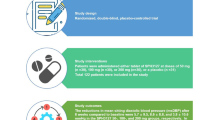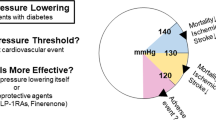Abstract
The objective of this study was to compare the safety and efficacy of nifedipine in two different formulations (osmotic pump and slow release microgranules) in patients with essential hypertension. A total of 91 patients with mild and moderate essential hypertension were recruited in a randomised, double-blinded trial, to receive a daily dose of 30 mg of nifedipine GITS or nifedipine slow release microgranules for 8 weeks. Patients who did not respond to the above-mentioned dose at week 4 of treatment received an increased dose of 60 mg per day of either drug for the remaining trial period. The primary end point of this study was the variation in mean sitting diastolic blood pressure (SDBP) from baseline values to the ones found at week 4 of treatment. The secondary end point was the variation in mean sitting systolic blood pressure (SSBP). Drug tolerability was measured according to incidence of side effects. The results were that both presentations reduced the mean SDBP and SSBP with similar efficacy. Drug side effects were also similar in both formulations. In conclusion nifedipine in slow release microgranules (NMG) is as effective as osmotic pump nifedipine (GITS) in reducing blood pressure with a similar tolerability profile.
This is a preview of subscription content, access via your institution
Access options
Subscribe to this journal
Receive 12 digital issues and online access to articles
$119.00 per year
only $9.92 per issue
Buy this article
- Purchase on Springer Link
- Instant access to full article PDF
Prices may be subject to local taxes which are calculated during checkout
Similar content being viewed by others
References
Guidelines Subcommittee 1999 World Health Organization-International Society of Hypertension. Guidelines for the Management of Hypertension J Hypertens 1999 17: 151–183
Brawnwald E . Mechanism of action of calcium-channel blocking agents N Engl J Med 1983 307: 1618–1627
Kaplan NM . Calcium entry blockers in the treatment of hypertension JAMA 1989 262: 817–823
Frishman WH, Charlap S, Michelson EL . Calcium-channel blockers in systemic hypertension Am J Cardiol 1986 58: 157–160
Waiters D et al. A controlled clinical trial to assess the effect of a calcium channel blocker on the progression of coronary atherosclerosis Circulation 1990 821: 940–953
Lichtlen PR et al. On Behalf of the INTAC Group Investigator. Retardation of angiographic progression ofcoronary artery disease by nifedipine. Results of the International Nifedipine Trial on Antiatherisclerotic Therapy (INTAC) Lancet 1990 335: 1109–1113
Chung M, Reitberg DP, Gaffney M . Clinical pharmacokinetics of nifedipine gastrointestinal system: a controlled-release formulation of nifedipine Am J Med 1987 83 (Suppl 3): 10–14
Salazar A, Arocha I . Efectividad antihipertensiva y tolerancia de la formulación osmótica de Nifedipina: Estudio multicéntrico venezolano Acta Clínica Bayer 1993 4: 11–15
Informe técnico científico de una nueva nifedipina para ser administrada cada 24 h Laboratorios Leti, Venezuela 1997
Coll Y, Rizzo A . Evaluación de la farmacocinética de dosis repetidas de nifedipina microgránulos 30 mg. Tensomax® Consejo Superior Científicas Barcelona, España 1993
Collet H, Uzcátegui I, Freites M, González M . Efectividad y tolerancia de una nueva formulación de nifedipina para ser administrada una vez al día en forma de micro partículas Arch Ven Farm y Terap 1997 16: 78–81
Roa E et al. Perfiles de presión arterial en 24 horas en pacientes con hipertensión arterial tratados con dos formulaciones de nifedipina. Informe preliminar Temática 2000 1: 16–19
Brown M et al. International nifedipine once-daily study intervention as goal in hypertension treatment Lancet 2000 356: 366–372
Roland Schmieder, Martus P, Klingbeil A . Reversal of left ventricular hypertrophy in essential hypertension JAMA 1996 275: 1507–1513
Yurenev AP, Dyakonova HG, Novkov ID . Management of essential hypertension inpatients with different degrees of left ventricular hypertrophy Am J Hypertens 1992 5: 5182–5189
Author information
Authors and Affiliations
Rights and permissions
About this article
Cite this article
Botero, R., Aroca, G., Asa, G. et al. Efficacy and safety of two different formulations of nifedipine (GITS) vs slow release microgranules in patients with mild and moderate hypertension. J Hum Hypertens 16 (Suppl 1), S156–S160 (2002). https://doi.org/10.1038/sj.jhh.1001364
Published:
Issue Date:
DOI: https://doi.org/10.1038/sj.jhh.1001364
Keywords
This article is cited by
-
Effectiveness of combination therapy with nifedipine GITS: a prospective, 12-week observational study (AdADOSE)
BMC Cardiovascular Disorders (2015)



